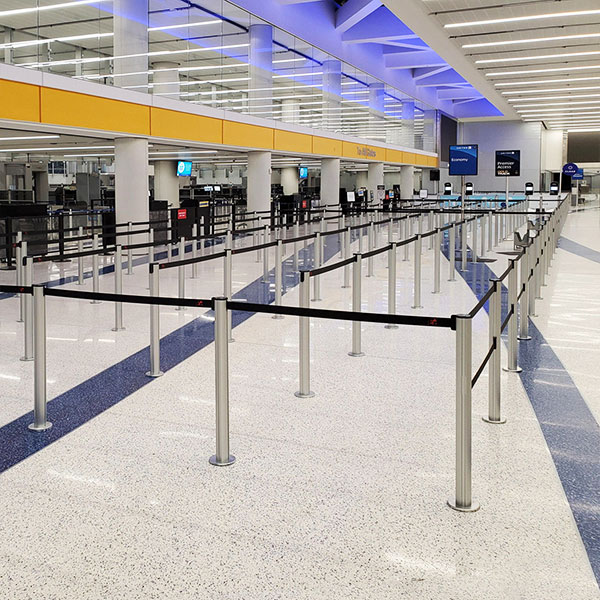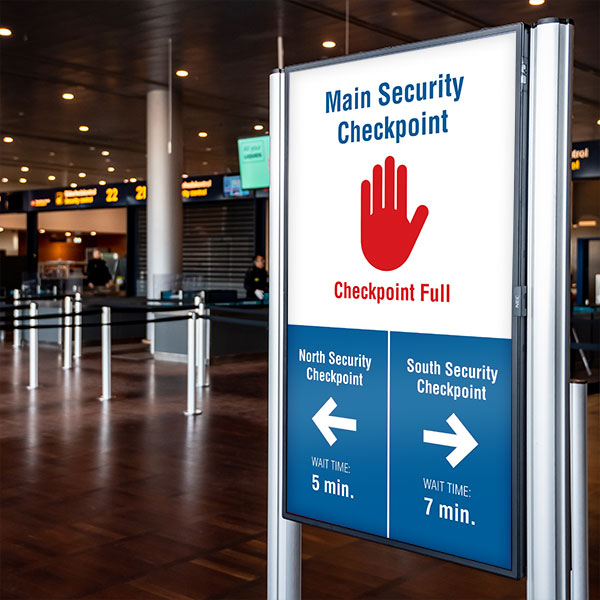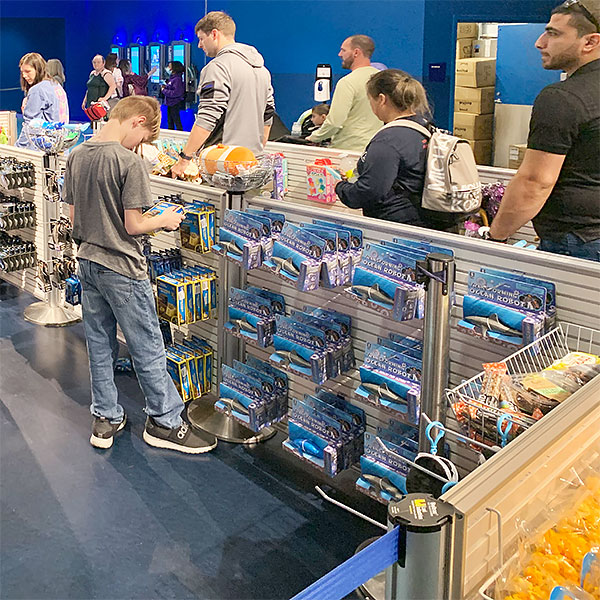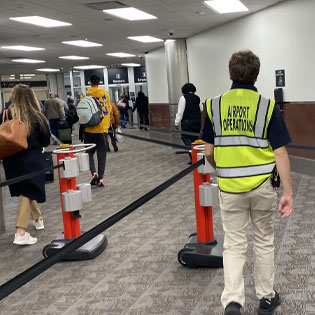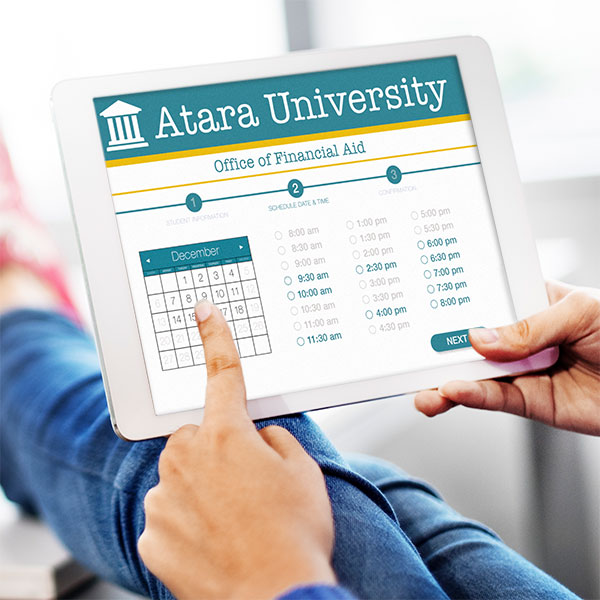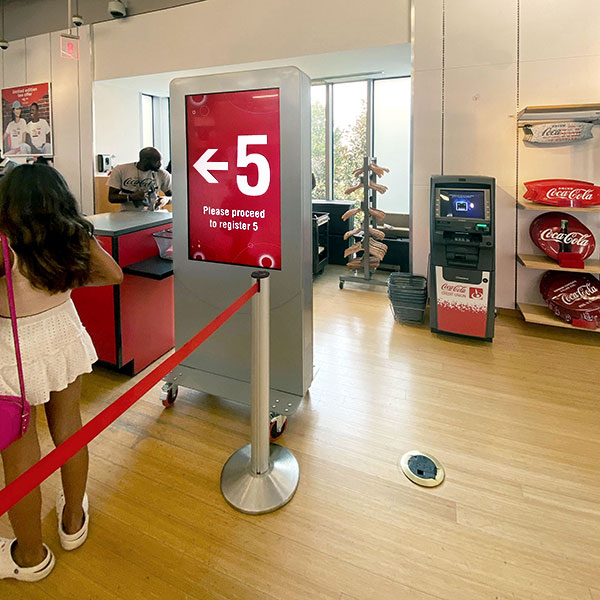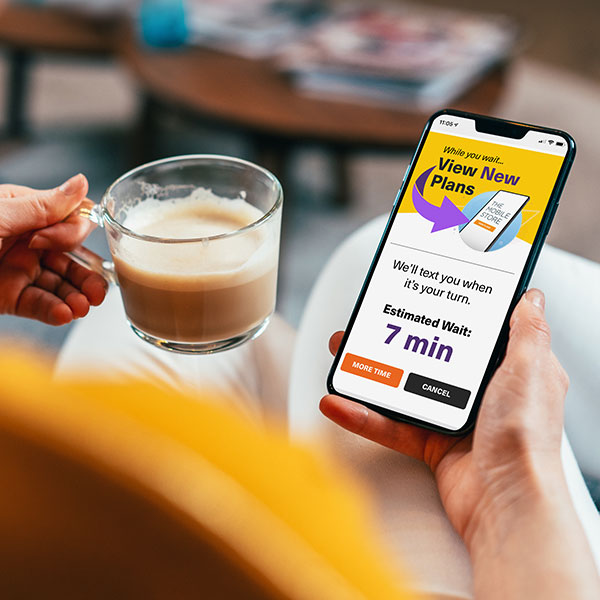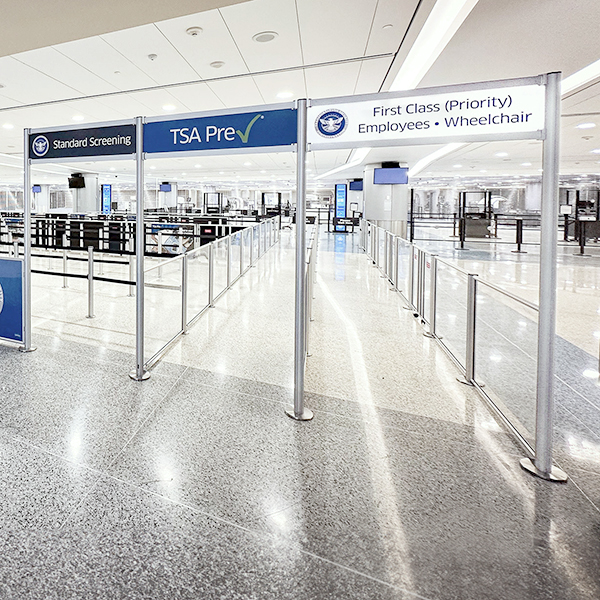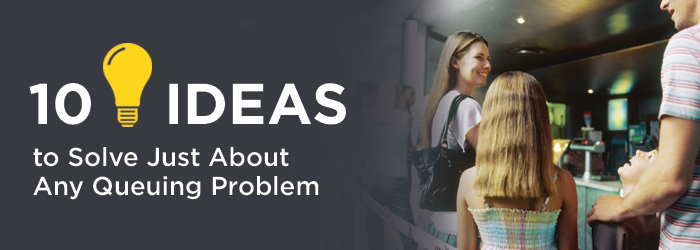
Updated: 10 Common Queue Problems and Solutions Your Customers Will Love
Every business is as unique as every waiting line. But there are some core challenges that every business faces. From maintaining queue integrity to keeping wait times in check, we’ve compiled some of our most popular queue management solutions to address the most common queuing problems for you here:
Idea #1: Magnetic Base Stanchions
Magnetic base posts help create a semi-permanent but flexible barrier that is designed specifically for high-traffic venues that call out for a sturdy stanchion that won’t shift out of place. The magnet firmly attaches to a floor-mounted steel plate, keeping the stanchion in place until you’re ready to move it for cleaning or rearranging the queue.
Problem solved: Compromised queue integrity
When your queue perimeter or partition wall is continually challenged to maintain its integrity as customer traffic flows through, you need a strong base. You want to avoid core-drilling stanchions into the floor but seek the integrity and strength of a permanent solution.
Idea #2: Publish Estimated Wait Times
Queuing expert David Maister established the theory that known waits feel shorter than unknown waits. Presenting people with an estimated wait time at the start of the queue sets the stage for a far more patient customer encounter. This can be accomplished with digital signage at the queue entrance, through text messaging integrated with a virtual queuing system, or with simple static signage at certain points in the queue.
Problem solved: Customer complaints about wait times
When customers know how long they’ll be expected to wait, they’re more likely to tolerate the wait and less likely to overestimate how long they've been waiting. And that makes for a more enjoyable waiting experience.
Idea #3: Start the Process Sooner
An interesting phenomenon occurs every day in grocery stores. When people start loading their groceries onto the conveyor belt, their dreaded wait in line is over. Mentally, at least, service has started. This lesson about getting the process started can be applied to other businesses as well. Consider In-N-Out Burger, where there is almost always a long line at the drive-through. Just as you’re questioning your sanity, an order-taker arrives at your car window to get your order started. A bank places stanchion-top tables and pens in the queue to get its customers started on paperwork before reaching the front of the line.
Problem solved: Wait Over. Service Started
There are many ways to inform and distract your customers while they wait their turn. Use digital signage to communicate standard procedures and processes. Add signage in the middle of the queue to help inform and prepare customers for what's to come. Install an in-queue table to provide a handy surface for customers to complete required paperwork. How can you get your customers started sooner?
Idea #4: Add Impulse Merchandising to Your Checkout
In-queue merchandising gives you the opportunity to market easy last-minute purchases to your customers through convenient in-line displays, bowls, baskets, and racks. In-line merchandising serves to not only boost impulse sales but also to keep people entertained and engaged while they wait. This can make the wait feel shorter, and the cash register ring higher.
Problem solved: Keep customers occupied while they wait
Waiting is a means to an end and something that plenty of customers hate. But waiting doesn’t have to feel boring or annoying. If you feel like your queue is lacking something, or you’re hearing directly from customers that the wait is far too painful, it’s time to keep patrons busy while boosting your bottom line.
Idea #5: Use Extra-Long Retractable Belt Barriers
Extra-long retractable belts that can be wheeled out to any location can provide the perfect answer. Take our own JetTrac™ Dual as an example. Its two 65-foot retractable belts make it easy to extend the queue in any direction as the need arises. And because it has a large wheeled base, it’s easy for a single employee to wheel out and set up – and just as easy to put away when the line goes down.
Problem solved: Unusually long lines
A large influx of customers arriving at the same time is an inevitable situation at airports. But many other businesses can experience a similar queuing challenge. When a sudden increase in customer arrival rates causes lines to back up into other areas of your facility, the resulting congestion can cause a whirlwind of problems.
Idea #6: A Single-Line, Multi-Server Queue Configuration
By implementing a single-line multi-server queue, there is less variation in the time a customer spends waiting. All customers experience a fair, first-come, first-served wait in a single-line queue. And, in this set-up, average wait times will decrease. Plus, eliminating the need for customers to choose the “right” line reduces their stress. If one transaction or customer is taking longer than another, the additional points of service keep the single line flowing instead of backing up one queue while other queues continue to move.
Problems solved: Queue jumping and reneging
When customers are dissatisfied with the queue they’re in, they may jump to another “better” queue. But the idea of “better” is relative. The queue might look shorter than the one a customer is in, but that doesn’t mean it’s working more efficiently or moving faster. The goal is to eliminate queue jumping entirely so customers don’t get frustrated when they choose the “wrong” line.
Idea #7: Pre-Scheduled Appointments
Let your customers set appointments or reserve their place in line before they arrive. When you operate a virtual queue equipped with scheduling software, customers can make a service appointment online or through a mobile app before they even arrive at your place of business.
Problems solved: Streamlined wait times and predictable workloads
If your customers know that your wait could be streamlined, faster, and just plain improved, then you owe it to them to consider the possibilities. Not only can the convenience of pre-scheduled absolutely delight customers, it can allow you to better manage the scheduling of your employees and the service workload. And, ultimately, the wait time is drastically reduced on the day of service.
Idea #8: Electronic Queuing
A call-forward electronic queuing system uses visual and audio queues to call customers to the next available service point. Confusion is lessened about what agent is available and customers don’t have to be super-focused on paying attention in the queue because they know their turn will come and they’ll be notified of it.
Problem solved: A more efficient way to call customers
Sure, it’s important for the next person in line to be hailed to the available service counter, but service agents yelling “Next in line!” every time a space opens up is undesirable in any situation.
Idea #9: Mobile Queuing
Eliminating the physical queue entirely can make you and your customers happier. Mobile queuing provides customers with the opportunity to do whatever they would like while they wait – whether people want to shop more or sit and rest somewhere or do anything else with their time, being freed from waiting in an actual line makes customers happier.
Problem solved: Disperse waiting crowds
When you’re looking to free up space that is taken up by a meandering queue or a jumble of people waiting for their turn at the counter, you need a queuing option that makes it easy for people to circulate and frees up floor space.
Idea #10: Directional Signage
Directional signage tells people where to go, where to wait for a service agent, where to find a shorter line, where a line begins or ends, and which line is appropriate for a person’s particular needs. Using clear language and images on directional signage eliminates customer frustration and makes it easy for customers to navigate in, around, and through your queue without confusion or the need for assistance. Directional signage also improves service efficiency overall by freeing agents from managing crowds so they can focus on serving customers.
Problem solved: A clear path to and through the queue
All queues are not created equal, and all queues are not intuitive. It’s detrimental to assume that every customer is going to automatically know their way around your waiting line or queuing area, especially if the queue is less than instinctive.
Hopefully some of the ideas presented here can address some of your own queue management challenges. Ready to plan your approach? Speak with a Lavi expert about your business needs.
SUBSCRIBE
Subscribe to stay up-to-date with new products, resources information and news.
RECENT RESOURCES
Theft at the Register: How Strategic Queue Design Protects Profits
ViewRapid Deployment Crowd Control: JetTrac Portable Barriers For The Biggest Spaces
View4 Psychological Reasons Your Customers Hate Waiting In Line
ViewFrom Bleachers To Bookstores: 4 Campus Crowd Control Solutions
View









